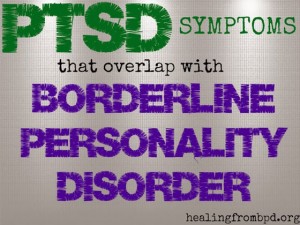BPD and PTSD: How common is the overlap?

Image courtesy of HealingfromBPD.org
How common is it to have a diagnosis of both Borderline Personality Disorder (BPD) and Post Traumatic Stress Disorder (PTSD)? This is a key question currently being considered in the mental health community. Studies show anywhere from 26% – 57% of comorbidity of these two disorders. “These findings further suggest that this particular personality disorder may be a variant of PTSD; however, it is not known how prevalent PTSD is in the other personality disorders” (PsychiatryOnline, American Journal of Psychiatry). A rationale behind the comorbidity rate is that PTSD can develop after experiencing a traumatic event that leaves one feeling unsafe or threatened. BPD develops partly from genetic predisposition along with an invalidating environment. Often, trauma occurs in this invalidating environment, which thereby causes the connection between the two disorders.
When we hear about someone experiencing trauma, we don’t always judge how intense or for how long the trauma was endured; yet this is very helpful to know so that we can gauge the severity in light of the duration. Was this a onetime event or an ongoing experience? According to Out of the Fog , an online resource, “C-PTSD (Complex-Post Traumatic Stress Disorder) results more from chronic repetitive stress from which there is little chance of escape.” This will most likely impact the type of treatment that’s most fitting and the approach to take.
Here are a couple of examples to assist with the differences between PTSD and C-PTSD:
“…a soldier returning from intense battle may be likely to show PTSD symptoms, but a kidnapped prisoner of war who was held for several years may show additional symptoms of C-PTSD. Similarly, a child who witnesses a friend’s death in an accident may exhibit some symptoms of PTSD, but a child who grows up in an abusive home may exhibit the additional C-PTSD characteristics…”
The “Complex” component of C-PTSD acknowledges the layers of persistent abuse or trauma that someone has experienced. The continued exposure of traumatic events or abuse is what may differentiate PTSD from C-PTSD.
There is also a large and intricate overlap in the symptoms experienced in both BPD and PTSD. Some of these are increased anxiety, emotional arousal or dysregulation, suicidal thoughts and feelings, feelings of guilt, shame or self-blame, or avoidance and numbing. When an individual suffers from both diagnoses at a time, it may be difficult to know where these symptoms originate.
A helpful stance to take can be to focus on treating the symptoms rather than the diagnosis. Dialectical Behavior Therapy, or DBT, can offer great assistance with the symptoms stated above. The skills learned through DBT can assist in managing the strong emotions common with these diagnoses.
Please note the importance of being in a place where you are ready to work on trauma recovery. A round of DBT therapy and or Skills Group would be preferable to try first to acquire skills to handle working on trauma. This is something to be discussed between you and your therapist.
A great article on this topic has been shared by Debbie Corso at HealingFromBPD.org.
